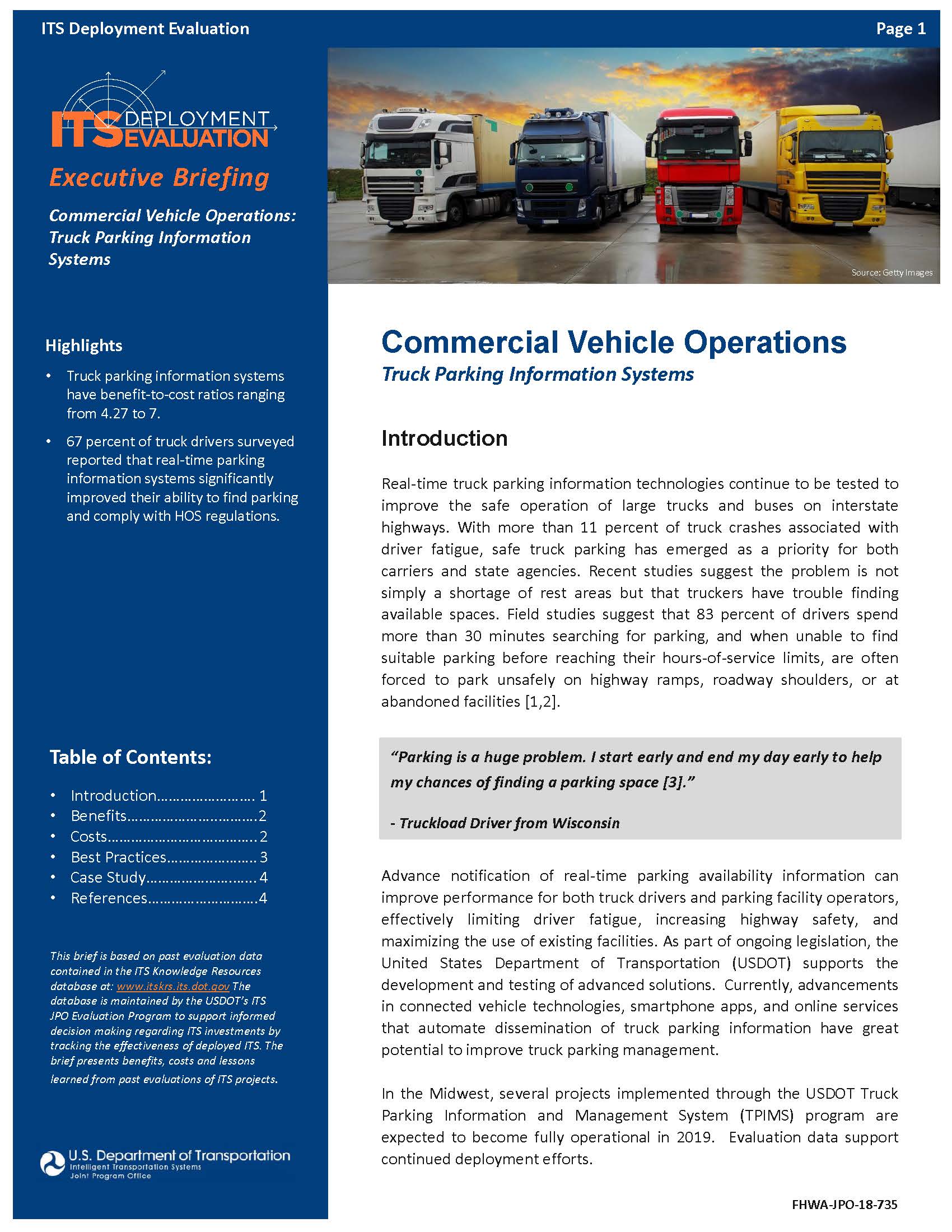2019 Executive Briefing
BRIEFING HIGHLIGHTS:
- Truck parking information systems have benefit-to-cost ratios ranging from 4.27 to 7.
- 67 percent of truck drivers surveyed reported that real-time parking information systems significantly improved their ability to find parking and comply with HOS regulations.
Introduction
Real-time truck parking information technologies continue to be tested to improve the safe operation of large trucks and buses on interstate highways. With more than 11 percent of truck crashes associated with driver fatigue, safe truck parking has emerged as a priority for both carriers and state agencies. Recent studies suggest the problem is not simply a shortage of rest areas but that truckers have trouble finding available spaces. Field studies suggest that 83 percent of drivers spend more than 30 minutes searching for parking, and when unable to find suitable parking before reaching their hours-of-service limits, are often forced to park unsafely on highway ramps, roadway shoulders, or at abandoned facilities [1,2].
| “Parking is a huge problem. I start early and end my day early to help my chances of finding a parking space [3].” - Truckload Driver from Wisconsin |
Advance notification of real-time parking availability information can improve performance for both truck drivers and parking facility operators, effectively limiting driver fatigue, increasing highway safety, and maximizing the use of existing facilities. As part of ongoing legislation, the United States Department of Transportation (USDOT) supports the development and testing of advanced solutions. Currently, advancements in connected vehicle technologies, smartphone apps, and online services that automate dissemination of truck parking information have great potential to improve truck parking management.
In the Midwest, several projects implemented through the USDOT Truck Parking Information and Management System (TPIMS) program are expected to become fully operational in 2019. Evaluation data support continued deployment efforts.
Benefits
Studies conducted as part of the statewide TPIMS program have shown that truck parking information management systems have benefit-to-cost ratios ranging from 4:27:1 to 7:1 (2018-01339 and 2018-01256).
Overall benefits include efficient routing, improved safety through enhanced driver fatigue management, and reduced infrastructure costs through better utilization of existing parking capacity.
Costs

The Statewide TPIMS in Colorado has a total estimated capital cost of $9 million (2016). The proposed system expected to be operational in 2019 will cover truck stops on three major freight corridors, including I-25 (917 truck parking spaces), I-70 (2,004 truck parking spaces), and I-76 (587 truck parking spaces). The integrated system will monitor commercial and public parking availability along these routes, distribute real-time parking availability information to operators and dispatchers, and facilitate parking reservations, all through multiple technology applications.
Static cameras and sensors will be used to monitor parking space availability, and allow transportation management centers to collect, verify, and share occupancy information using cellular modems and an existing fiber optic network (2018-00397).
Estimated deployment costs for the statewide system are summarized in Table 1.
| Cost Area | Cost |
|---|---|
| Project Management, Research, Marketing, and Analytics | $915,000 |
| Construction (3 sites) | $5,500,000 |
| Infrastructure Planning and Design (25% of Construction) | $1,375,000 |
| Integration (10% of Construction) | $550,000 |
| Construction, Engineering and Inspection (CEI, 12% of Construction) | $660,000 |
| Total Capital Cost | $9,000,000 |
| “The Colorado TPIMS would improve freight delivery reliability and shipping time efficiency by reducing the costs and delays associated with truck drivers searching for available parking areas... [4]” Colorado Department of Transportation |
Early prototypes developed for the USDOT SmartPark initiative were estimated to cost $391,000 per site with $5,500 projected for routine annual O&M. These systems used entrance/exit scanners and CCTV cameras in parking areas to verify parking information posted on roadside dynamic message sign (DMS) units (2019-00412). Follow-up deployments that leveraged improved camera and communication systems had lower baseline costs ranging from $70,000 to $120,000 per site, and included options to add automated parking space surveillance systems and disseminate parking information in real-time using in-cab messaging and internet websites (2018-00411).
Best Practices
One of the most significant causes of truck drivers not complying with hours-of-service (HOS) regulations—which leads to trucker fatigue and accidents—is the lack of awareness of available truck parking. At the direction of the National Transportation Safety Board (NTSB) the FMCSA led an initiative to better inform truckers of available truck parking by piloting a truck parking information system and analyzing the efficacy of the system. In 2015, FMCSA published a paper guide to inform truck drivers about locations and availability of parking and in 2018 published a report detailing lessons learned from ongoing operations at a demonstration site located at a rest stop near Athens, TN. The system was designed with infrared scanners and Doppler radar to detect and classify vehicles at entry/exit points, CCTV cameras to verify parking space availability, and a traveler information utility to broadcast real-time parking information to truckers via freeway DMS units, a mobile application, a public website, and a telephone interactive voice response system (IVR) (2018-00832).
Key lessons learned from the demonstration project included the following:
Surveillance and Detection Systems

Figure 2: High-mounted Camera and Detector. Source: Getty Images Detectors. If properly installed, infrared and Doppler radar detectors can accurately classify and count vehicles entering and exiting a site. However, due to variations in the installation of a detector, a vehicle may be classified differently when entering and leaving a site, leading to vehicle count compounding errors over time. Even small error rates can result in incorrect parking availability information after 1–2 days. For this reason, the system must be calibrated at least once per day to maintain acceptable accuracy levels.
- Cameras. Installation of a single high-mounted, pan/tilt/zoom (PTZ) camera may eliminate the need for numerous static cameras required to calibrate detection systems and verify parking availability information. This would reduce ongoing bandwidth costs to the site and reduce maintenance costs by minimizing the quantity and type of field equipment.
Traveler Information Systems
The traveler information system used in the demonstration project included freeway DMS systems, a mobile application, a public Web site, and a telephone IVR system. Data collected on usage of the various components showed that the most useful aspect of the traveler information system was by far the DMS, which reached all passing motorists and was strategically placed to maximize the utility of the information. Although it was clear that the DMS system reached a much wider audience, mobile applications and websites should not be disregarded or marginalized as traveler information tools. Truckers accustomed to using mobile applications benefit significantly from having information on truck parking availability. However, a standalone application limits the number of users. Usage will be far more widespread if the data becomes open and available for integration with other applications that are already in use.
Case Study
A Comprehensive System for Assessing Truck Parking Availability
A recent field study conducted by the University of Minnesota evaluated the top factors influencing truck driver parking decisions as they approach HOS driving limits. Findings show that drivers prefer to receive real-time parking information via onboard computer applications or roadside DMS units located in advance of rest stops. Real-time messages that included information on the exact number of spaces available or the status of truck parking (e.g., “Space Availability: Low”) were preferred. Approximately 50 percent of drivers indicated the information had positive impacts on their productivity while 67 percent reported the information significantly improved their ability to find parking and comply with HOS regulations. Interestingly, 60 percent of drivers ranked onboard computers as the most preferred method for receiving truck parking availability information, followed by roadside DMS, smart phone applications, and a website (2018-01340).
References
- MAASTO Truck Parking Survey Analysis May 2018. American Transportation Research Institute. Arlington, VA. May 2018. https://trucksparkhere.com/wp-content/uploads/2018/09/Phase-2-MAASTO-Truck-Parking-Survey-Report_OnlineVersion.pdf.
- “MAASTO Regional Truck Parking: Truck Parking Information Management System (TPIMS).” Freight Advisory Council, Iowa DOT, September 14, 2018. https://iowadot.gov/systems_planning/freight/FAC/TPIMS.pdf.
- Managing Critical Truck Parking Case Study – Real World Insights from Truck Parking Diaries. American Transportation Research Institute, Arlington, VA, December 2016. https://atri-online.org\wp-content\uploads\2016\12\ATRI-Truck-Parking-Case-Study-Insights-12-2016.pdf.
- "Colorado Truck Parking Information Management System.” Fastlane, Colorado Department of Transportation., Denver, CO., April 14 2016. https://www.codot.gov/programs/planning/documents/plans-projects-reports/projects/fastlane-applications/truck-parking-information.pdf.


